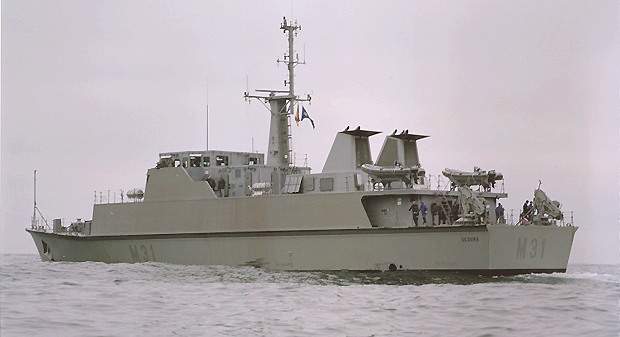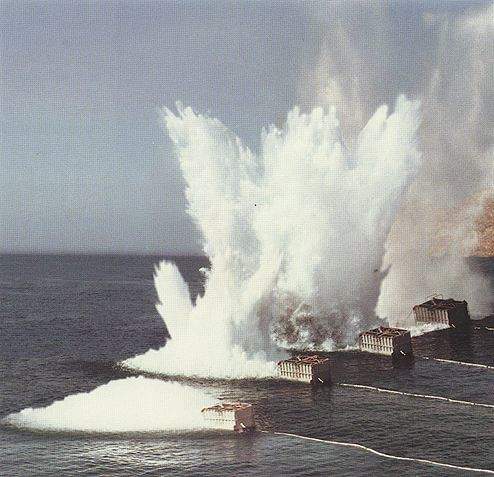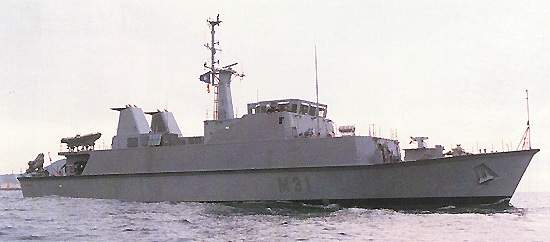Six Segura class minehunters have been built for the Spanish Navy by the Spanish shipbuilders Navantia (formerly Bazan, then Izar) at the Cartagena shipyard. Segura (M31) was commissioned in November 1998, Sella (M32) in 1999, Tambre (M33) in February 2000 and Turia (M34) in September 2000.
In January 2001, the Spanish Navy ordered a further two Segura class minehunters, Duero and Tajo. Duero was commissioned in July 2004. Tajo was launched in June 2004 and delivered in January 2005.
The main mission is the clearance of mines in the entrance to ports, naval bases and coastal sea lanes. Mines are cleared to a depth of 200m for bottom mines and 300m for moored mines. A secondary mission is to guide other shipping through the channels which have been cleared in the minefields.
Design
Segura minehunters are able to withstand the shock of underwater explosions through the use of glass fibre-reinforced plastic for the hull and superstructure and the selection of shock-resistant equipment and systems.
The hull is constructed with a single skin of GRP with longitudinal stiffeners in the base and traverse frames along the sides. A skin of vinylester resin is used on the outer layer to provide a barrier against the ingress of water.
As well as GRP, low magnetic materials have been used such as stainless steel, aluminium alloys and copper alloys for fastening and mounting systems. In addition all the electric motors are of low magnetic material content and have compensated stray fields. The ship’s degaussing is made up of 25 coils for the ship’s structure as a whole and local coils for specific items of equipment.
The machinery spaces comprising the main engine room, auxiliary machinery room and the diesel generator room are located between main watertight bulkheads in the stern. The diesel generator room is located on the main deck in order to minimise noise below the waterline. The remotely operated mine disposal vehicle (ROV) launch and recovery area is on the afterdeck which is equipped with two cranes. A closed hangar provides storage and maintenance facilities for the ROVs and support facilities for divers, including two rigid inflatable boats fitted with silent outboards and a decompression chamber.
Command and control
A FABA integrated modular command and control system is used to plan, execute, evaluate and record data for all minehunting operations. The system is interfaced with the sonar, ROVS, radar and various other equipment via three net access modules.
Gun
The main gun is an Izar/Oerlikon 20mm GAM-BO1 gun which is used for the destruction of mines on the surface.
Mine countermeasures
The ship has a fully integrated minehunting and mine disposal management system which is able to detect, classify, identify and destroy any type of mine within an operating depth of 300m. The system has the ability to record and save all operating data for future use. The system includes two Gayrobot Pluto Plus Mine Identification and Disposal ROV’s equipped with underwater cameras.
In September 2002, the Spanish Navy ordered the Kongsberg Defence and Aerospace Minesniper one shot mine disposal system, for installation on the two new Segura minehunters being built by Izar. Minesniper is based on a remotely controlled semi-submersible vehicle with scanning sonar. The Minesniper is 2m long and weighs about 30kg and has a range of 4,000m. The contract was extended in December 2004 to include retrofit to the four other Segura vessels.
able to detect, classify, identify and destroy any mine within an operating depth of 300m.”
Sensors
The minehunting sonar is the AN/SQQ-32 variable-depth sonar (VDS) from Raytheon and Thales (formerlyThomson-CSF). The main function of the VDS is the detection and classification of mines but it can also function as a side scan sonar. The sonar sensor arrays are installed in a towed body that can be deployed at a depth over 200m or it can be fixed to function as a hull sonar
Propulsion
The ships have a diesel engine for cruising and an electric engine for silent propulsion during minehunting operations. The ships are fitted with two independent Voith Schneider 18GH cycloidal propellers, which provide propulsion and steering in cruising and minehunting modes, and two twin tube bow thrusters.
Each power plant is installed on a rigid sub-base which is mounted on the hull with vibration isolation rubber mounts. The two Izar-MTU 6V 396 diesel engines are rated at 560kW each for cruising propulsion. The two low magnetic field electric motors feature compensated stray fields and are each rated at 125kW for minehunting.








